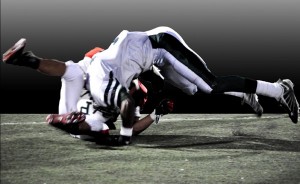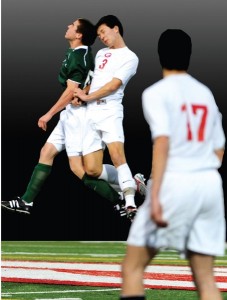Imagine your body being slammed into artificial turf by a 200 pound linebacker wearing a helmet with padding as hard as wood. Imagine your head smacking the ground, then whipping back into place, all in under a second. Ask Palo Alto High School offensive tackle Michael Lyzwa (’12) how it feels. Actually, ask the players on the sidelines, because Lyzwa will not remember; he suffered a concussion.
“I just remember being in one play and then things just started going bad,” Lyzwa said. “I couldn’t open my eyes, I felt really light headed.”
In between the lines of the patchy story Lyzwa tells lies the scary reality that his teammates witnessed during that late August practice at Paly. Lyzwa was unable to speak fluidly, open his eyes or recognize his teammates after his concussion. He could not stand on his own, and had to be propped up. No matter how many times Lyzwa hears the story, he will not remember this occurrence, which became a red flag to all who witnessed it.
THE WORD CONCUSSION derives from the Latin word “concutere,” which literally means “to shake violently.” A force to the head can cause the brain to move around inside the skull. This shaking can cause bruises, nerve injuries and blood vessel damage, resulting in memory loss, and in the most severe cases, death.
“The symptoms [I got after my concussion] lasted for a few days,” Lyzwa said. “I was feeling really [bad], sensitive to light and sound, [my] reaction time was really slow. I had on and off headaches.”
Lyzwa is not the only person around Paly who has suffered from these post-concussion symptoms. Despite the fact that the football team has played just four games this year, both Lyzwa and lineman Kevin Kannappan (’12), whose concussion occurred 15 days after Lyzwa’s, have fallen victim to concussions this season.
Concussions can cause cognitive problems, which can lead to difficulties playing or thinking. Symptoms last from a few hours to several months. Concussions can occur in any sport, at any time. They can compromise athletes’ ability to think, but if addressed with proper medical attention, a player may return to the field to finish out the season. In attempt to curb the amount of concussions that occur at the high school level, the California Interscholastic Federation (CIF) created a new rule to raise awareness about this growing issue in high school sports.
IN A HIGHLY PUBLICIZED worst-case scenario, Greenville Rose High School (N.C.) running back Jaquan Waller suffered a concussion. After a second case of head trauma, he was diagnosed with Second Impact Syndrome (SIS) and later died.
Another example of SIS occurring in high school sports took place much closer to home.
Matt Blea, a football player at San Jose Academy High, suffered from a concussion in a game against Lincoln High School on Thanksgiving Day in 2009. After passing out on the sideline, Blea went to the hospital where he had three different brain surgeries and was diagnosed with a fractured skull and Second Impact Syndrome. Doctors kept Blea in a medically induced coma for a week while he was considered to be in critical condition. Then, after seven days had elapsed, Blea awoke to the relief of the entire community, with memory of the game up until that play.
SIS occurs when two head injuries, even if they are relatively minor, occur in a short period of time, and the auto-regulation of blood supply in the brain is immediately cut off. A brain herniation takes from two to five minutes to form. The outcome can result in lifelong physical and mental problems. According to a report by ESPN’s Outside the Lines, 50 percent of cases result in death.

Although Blea’s story ends with recovery, the incident instilled a sense of urgency in the high school football community, and serves as a reminder that adolescents playing contact sports, according to ESPN, are the most susceptible to SIS.
However, football is not the only affected sport. Riley Smith (’11), a former Paly student and avid soccer player, was forced to hang up his cleats prematurely due to multiple concussions.
Boys like Lyzwa suffer head trauma from injuries from sports with less contact. However, boys are not always the most susceptible.
According to The Journal of Athletic Training, in soccer, girls suffer from concussions 68 percent more often than boys. Although there are no medical explanations for this, some theories argue that girls have weaker neck muscles than boys.
Paly Athletic Director and head football coach Earl Hansen agrees with these theories. He believes that girls are often more susceptible to concussions due to weaker muscles, and a lack of head stability.
“Good workout procedures, as far as building lats and traps to build stability [help strengthen the neck muscles and can prevent concussions],” Hansen said.
This theory argues that due to the lack of neck strength, girls’ heads are at a higher risk of being shaken. Without the stability that many boys develop through lifting, the female brain can be knocked around more.
Holly Mckenna (‘11), a soccer player for Henry M. Gunn High School, sustained three concussions. She admits to being scared of future complications related to concussions, but still continues to play.
“My doctor kind of scared me,” McKenna said. “He was just saying that I would get Alzheimer’s so he was trying to scare me into not playing. It’s definitely scarier going back [into soccer] and going up for headers is a lot scarier, because I’m not the type of person that would change my [style of play].”
McKenna’s actions could be called brave, but when does acting brave turn into acting recklessly? In sports, players are often taught to tough itIn sports, players are often taught to tough it out and keep playing. In the circumstance of a concussion, not only is this extremely dangerous, but it can also turn lethal.
Clay Carey (’12) played football during his freshman and sophomore years, and continues to play baseball for Paly. During his sophomore football season, Carey obtained a concussion.
“Now I don’t worry about [SIS] because it’s only been one [concussion], but if I get a few more then I’d start to take preventative measures,” Carey said.
With such a risk for SIS and concussions in high school athletics, and a splurge of media coverage including features in Time Magazine, The New York Times and ESPN, the public is becoming more aware.
THE CIF PASSED Bylaw 313 on May 7, 2010, in an attempt to raise awareness about the damaging effects of concussions in high school sports. Bylaw 313 allows referees to determine if an athlete is concussed, and whether or not he or she will be able to return to the game. A player cannot begin to participate again until he is examined and cleared by a doctor.
This rule gives referees the power to significantly alter a game, by removing players from the competition, or by choosing to leave them in. People in the sports world question whether this is effective due to officials’ lack of medical expertise.
Certain referees share this uneasiness, citing that it is not their responsibility.
“[The problem] that the officials are having is that they don’t feel qualified,” CIF assistant commissioner Duane Morgan said. “Honestly, they have always had the power to pull a player from the game, [but] some of them never realized that. It now becomes their responsibility.”
Even with careful use of this power, people harbor concern about the referees’ ability to dictate the severity of an injury.
“It’s a lot of pressure on the ref, especially since they are not doctors,” Paly lineman Kevin Anderson (’11) said.
While some are cautious of this rule because referees are not doctors, the referees are instructed on how to properly diagnose a concussion. A free online program is available through the National Federation of State High School Athletics that deals with concussion protocol. All coaches and referees have access to the program.
“We have got some good access to educational material on concussions that will make people aware,” Santa Clara Valley Athletic League referee Ray Miailovich said.
Stacey Kofman, an athletic trainer at Paly for 17 years, believes the rule is a step in the right direction, but it needs more work.
“If it were just up to the coaches, they [would] always play the player, but if there is somebody there who is qualified [to assess a player’s condition], it should be left to those who are qualified to make the decisions,” Kofman said.
With Bylaw 313 giving referees more power, coaches have voiced some concerns about the rule’s impact on games.
“So far the refs have been very responsible,” Hansen said. “It’s not the player’s choice [on whether a player should be taken out of the game].”

Because this rule has been in effect for less than a year, it is difficult to measure its success.
STORIES ABOUT BIG HITS in football dominate the headlines, but the most dangerous outcomes can be a result of consecutive, relatively minor head traumas that occur within a short time of each other. They can happen to both genders in any sport.
While some players like former football and baseball player Carey are not scared of concussions, the realities of worst case scenarios like those of Waller and Blea often reside in the back of athletes’ minds.
“The big thing is, if a player has had a hard hit, not only in football, but in any sport, to let the coach know,” Frederick Mueller, Ph.D. and director of the National Center for Catastrophic Injury Research, said. “[He needs to] realize that he is not letting people down but quite honestly he is helping the team by letting them know that he has a problem and can’t continue playing.”
No athlete dreams of having his or her career cut short by injuries. Parents never want to see their child endure a debilitating and mentally traumatic head injury. Concussions are a huge concern in the high school sports community and cannot be overlooked. Whether from the hit of a 200 pound linebacker or from the impact of colliding with a player in a soccer game, a concussion always needs to be treated seriously.
In the words of Riley Smith, one youth forced to give up his passion due to three concussions, “I hope this article keeps people from doing what I did.”




